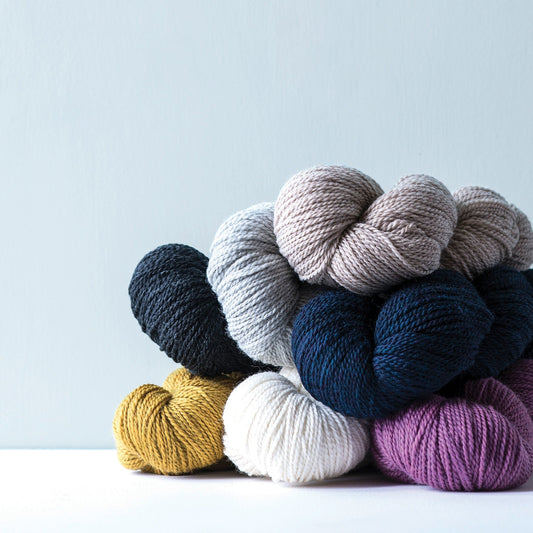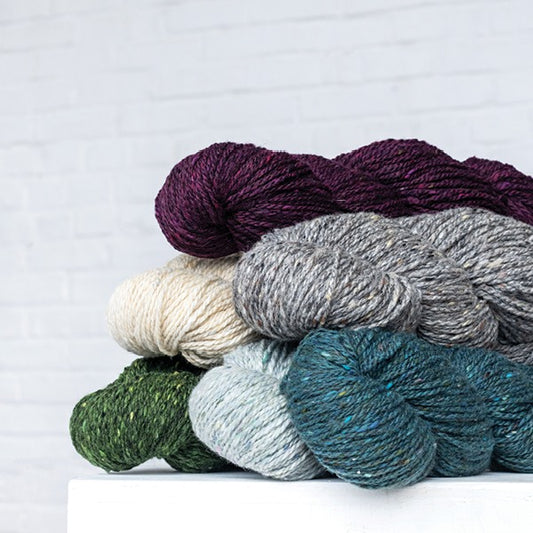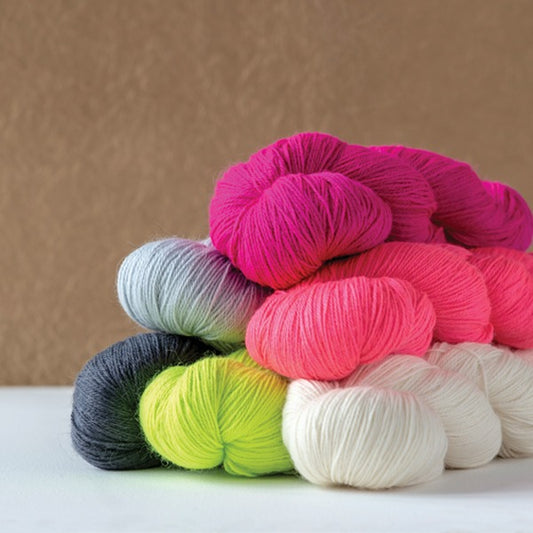This year I'm individually going over each Kelbourne Woolens yarn, and will discuss the characteristics, gauges, and go over a few different swatches and stitch patterns. You can view the first post on Lucky Tweed here and the second on Andorra here!

Next up in our swatching series is
Scout, one of the most popular yarns in the Kelbourne Woolens lineup!
Yarn Label
As mentioned previously, yarn labels tell you a lot about the yarn, and ours are no exception.
 A few notes:
Fiber content:
A few notes:
Fiber content: Much like
Lucky Tweed,
Scout is 100% wool. But unlike Lucky, which is merino, Scout is highland wool. As with the Highland wool in Andorra, the wool is Scout is a cross between Corriedale and Merino. It is not as soft as Merino, but it is stronger and adds durability and strength to the yarn.
Yarn Characteristics
Scout is a classic DK weight yarn. It is heavier than
Andorra,
Perennial,
Mojave, and
Camper, but lighter than
Germantown and
Lucky Tweed. A 2-ply yarn, it is unique in that it is a heather, meaning multiple colors are pre-blended prior to spinning to create a shade with a lot of depth and variation. Natural is the one exception to this - it is the undyed white shade of wool.

The Swatches!
Stockinette Stitch: Kuutar by Sari Nordlund is a yoke pullover with an intricate lace pattern at the yoke and sleeve cuffs (although I'd probably omit the design at the cuffs and do classic ribbing, as they feel a little too feminine for my taste).
Passerine by Chloe Elizabeth Birch from the latest issue of
Pom Pom is a simple design with a gorgeous feather detail on each sleeve.
Kuutar has a gauge of 20 stitches and 27 rows to 4" and Passerine 22 stitches and 32 rows to 4".
I'm not going to copy my whole spiel about gauge and needle size here again, but if you need a refresher or aren't yet 100% convinced, you can view it in the Lucky Tweed post here.
 US 5 / After blocking: 20 sts and 26 rows = 4″
US 6 / After blocking: 22 sts and 28 rows = 4″
Matching stitch gauge for these two patterns was very easy, as I know Scout works well and looks great at both 20 and 22 stitches to 4". Row gauge, as always, is a little trickier.
As I am getting an ever so slightly tighter (more rows per 4") gauge than as written in the pattern on my swatch, there is a chance my yoke won't be long enough as written and I may need to add more stockinette rounds. Since Kuutar is knit from the top down, I'd pay attention to my row gauge in the yoke stitch pattern, and even go as far as to block it and measure the yoke depth prior to separating for the body and sleeves.
My row gauge for Passerine is off by more - I am getting 28 versus the 32 as written - and this will require more adjustment and planning. As the body and sleeves are knit in pieces, I'd use the body as a secondary swatch, count rows, not inches, and block after I've knit about 12" to make sure my math is correct. Luckily, it is easier to sort out the math when adding rows, especially when doing shaping such as raglan, so it shouldn't be difficult to adjust and still make sure the fit matches that as written.
Stitch Patterns: After seeing Salena's test knit of the Molly Sweater by shinysuperhero, I became a woman possessed. It is knit in all over stranded colorwork from the top down and features steeking at the neck and sleeves. Rainberry by Faye Kennington is also knit from the top down in a new-to-me heavily textured stitch.
Stranded Colorwork: Molly has a gauge of 20 sts and 26 rows to 4".
We just released 5 new colors in Scout, including some lovely mid tone neutrals, so I wanted to find a way to incorporate some of them and also step out of my color comfort zone a bit. So I swatched. And changed colors. And swatched more. And nothing was perfect. And then I hit a wall.
I've given myself a bit of a break in order to reassess what is working (the top two bands on both swatches - the gray background with the pinks and browns on the left, and the meadow background with the light neutrals on the right - are very close) and what most definitely was a flop (some of the contrast colors just didn't have enough visibility...and the coral paired with the chestnut is a weird 70s nightmare) and my plan is to try again, without forcing myself into something that isn't "me" enough to make knitting something of this magnitude worth the effort. Despite the slight roadblock, I'm still very excited about the sweater, so I will prevail!
US 5 / After blocking: 20 sts and 26 rows = 4″
US 6 / After blocking: 22 sts and 28 rows = 4″
Matching stitch gauge for these two patterns was very easy, as I know Scout works well and looks great at both 20 and 22 stitches to 4". Row gauge, as always, is a little trickier.
As I am getting an ever so slightly tighter (more rows per 4") gauge than as written in the pattern on my swatch, there is a chance my yoke won't be long enough as written and I may need to add more stockinette rounds. Since Kuutar is knit from the top down, I'd pay attention to my row gauge in the yoke stitch pattern, and even go as far as to block it and measure the yoke depth prior to separating for the body and sleeves.
My row gauge for Passerine is off by more - I am getting 28 versus the 32 as written - and this will require more adjustment and planning. As the body and sleeves are knit in pieces, I'd use the body as a secondary swatch, count rows, not inches, and block after I've knit about 12" to make sure my math is correct. Luckily, it is easier to sort out the math when adding rows, especially when doing shaping such as raglan, so it shouldn't be difficult to adjust and still make sure the fit matches that as written.
Stitch Patterns: After seeing Salena's test knit of the Molly Sweater by shinysuperhero, I became a woman possessed. It is knit in all over stranded colorwork from the top down and features steeking at the neck and sleeves. Rainberry by Faye Kennington is also knit from the top down in a new-to-me heavily textured stitch.
Stranded Colorwork: Molly has a gauge of 20 sts and 26 rows to 4".
We just released 5 new colors in Scout, including some lovely mid tone neutrals, so I wanted to find a way to incorporate some of them and also step out of my color comfort zone a bit. So I swatched. And changed colors. And swatched more. And nothing was perfect. And then I hit a wall.
I've given myself a bit of a break in order to reassess what is working (the top two bands on both swatches - the gray background with the pinks and browns on the left, and the meadow background with the light neutrals on the right - are very close) and what most definitely was a flop (some of the contrast colors just didn't have enough visibility...and the coral paired with the chestnut is a weird 70s nightmare) and my plan is to try again, without forcing myself into something that isn't "me" enough to make knitting something of this magnitude worth the effort. Despite the slight roadblock, I'm still very excited about the sweater, so I will prevail!
 US 7 / After blocking: 20 sts and 23 rows = 4″
As Molly is knit from the top down and steeks occur on both the neck and armholes, row gauge is as important as stitch gauge with this design. As I've matched stitch gauge but my row gauge is looser than the pattern calls for, my plan when I start knitting is to block pretty vigorously after working the initial yoke section in order to make sure I'm not going too deep. Once the yoke is sorted, it will be a lot easier to make sure the sleeves and body are proper length.
Rainberry Pattern: I initially overlooked the pattern in my searching because it was short sleeved and striped - two things I wasn't looking for in a Scout sweater - but upon closer inspection, I became very intrigued by the stitch pattern and really wanted to try it out! The gauge for Rainberry is 12 stitches and 16 rows (1 pattern repeat) = 2.25” wide and 2" long.
US 7 / After blocking: 20 sts and 23 rows = 4″
As Molly is knit from the top down and steeks occur on both the neck and armholes, row gauge is as important as stitch gauge with this design. As I've matched stitch gauge but my row gauge is looser than the pattern calls for, my plan when I start knitting is to block pretty vigorously after working the initial yoke section in order to make sure I'm not going too deep. Once the yoke is sorted, it will be a lot easier to make sure the sleeves and body are proper length.
Rainberry Pattern: I initially overlooked the pattern in my searching because it was short sleeved and striped - two things I wasn't looking for in a Scout sweater - but upon closer inspection, I became very intrigued by the stitch pattern and really wanted to try it out! The gauge for Rainberry is 12 stitches and 16 rows (1 pattern repeat) = 2.25” wide and 2" long.
 US 7 / After blocking: 17 sts and 32 rows = 4″ / 1 pattern repeat = 2.75" wide and 2" long.
My stitch gauge is much too dense, but my row gauge is spot on. If I was planning on knitting the sweater, I'd go up a needle size to match the stitch gauge, but I actually quite like the fabric as-is, and could see it being very cute as a hat or even mittens!
I'm doing the final finishes on my Toni in Lucky and cast on a new sweater sleeve in Andorra while working the polls in May. Following my trend of casting on a sweater in whatever I've been swatching, it's safe to say a new sweater in Scout is next!
US 7 / After blocking: 17 sts and 32 rows = 4″ / 1 pattern repeat = 2.75" wide and 2" long.
My stitch gauge is much too dense, but my row gauge is spot on. If I was planning on knitting the sweater, I'd go up a needle size to match the stitch gauge, but I actually quite like the fabric as-is, and could see it being very cute as a hat or even mittens!
I'm doing the final finishes on my Toni in Lucky and cast on a new sweater sleeve in Andorra while working the polls in May. Following my trend of casting on a sweater in whatever I've been swatching, it's safe to say a new sweater in Scout is next!
 Next up in our swatching series is Scout, one of the most popular yarns in the Kelbourne Woolens lineup!
Next up in our swatching series is Scout, one of the most popular yarns in the Kelbourne Woolens lineup!
 A few notes:
Fiber content: Much like Lucky Tweed, Scout is 100% wool. But unlike Lucky, which is merino, Scout is highland wool. As with the Highland wool in Andorra, the wool is Scout is a cross between Corriedale and Merino. It is not as soft as Merino, but it is stronger and adds durability and strength to the yarn.
A few notes:
Fiber content: Much like Lucky Tweed, Scout is 100% wool. But unlike Lucky, which is merino, Scout is highland wool. As with the Highland wool in Andorra, the wool is Scout is a cross between Corriedale and Merino. It is not as soft as Merino, but it is stronger and adds durability and strength to the yarn.

 US 5 / After blocking: 20 sts and 26 rows = 4″
US 6 / After blocking: 22 sts and 28 rows = 4″
Matching stitch gauge for these two patterns was very easy, as I know Scout works well and looks great at both 20 and 22 stitches to 4". Row gauge, as always, is a little trickier.
As I am getting an ever so slightly tighter (more rows per 4") gauge than as written in the pattern on my swatch, there is a chance my yoke won't be long enough as written and I may need to add more stockinette rounds. Since Kuutar is knit from the top down, I'd pay attention to my row gauge in the yoke stitch pattern, and even go as far as to block it and measure the yoke depth prior to separating for the body and sleeves.
My row gauge for Passerine is off by more - I am getting 28 versus the 32 as written - and this will require more adjustment and planning. As the body and sleeves are knit in pieces, I'd use the body as a secondary swatch, count rows, not inches, and block after I've knit about 12" to make sure my math is correct. Luckily, it is easier to sort out the math when adding rows, especially when doing shaping such as raglan, so it shouldn't be difficult to adjust and still make sure the fit matches that as written.
Stitch Patterns: After seeing Salena's test knit of the Molly Sweater by shinysuperhero, I became a woman possessed. It is knit in all over stranded colorwork from the top down and features steeking at the neck and sleeves. Rainberry by Faye Kennington is also knit from the top down in a new-to-me heavily textured stitch.
US 5 / After blocking: 20 sts and 26 rows = 4″
US 6 / After blocking: 22 sts and 28 rows = 4″
Matching stitch gauge for these two patterns was very easy, as I know Scout works well and looks great at both 20 and 22 stitches to 4". Row gauge, as always, is a little trickier.
As I am getting an ever so slightly tighter (more rows per 4") gauge than as written in the pattern on my swatch, there is a chance my yoke won't be long enough as written and I may need to add more stockinette rounds. Since Kuutar is knit from the top down, I'd pay attention to my row gauge in the yoke stitch pattern, and even go as far as to block it and measure the yoke depth prior to separating for the body and sleeves.
My row gauge for Passerine is off by more - I am getting 28 versus the 32 as written - and this will require more adjustment and planning. As the body and sleeves are knit in pieces, I'd use the body as a secondary swatch, count rows, not inches, and block after I've knit about 12" to make sure my math is correct. Luckily, it is easier to sort out the math when adding rows, especially when doing shaping such as raglan, so it shouldn't be difficult to adjust and still make sure the fit matches that as written.
Stitch Patterns: After seeing Salena's test knit of the Molly Sweater by shinysuperhero, I became a woman possessed. It is knit in all over stranded colorwork from the top down and features steeking at the neck and sleeves. Rainberry by Faye Kennington is also knit from the top down in a new-to-me heavily textured stitch.
 US 7 / After blocking: 20 sts and 23 rows = 4″
As Molly is knit from the top down and steeks occur on both the neck and armholes, row gauge is as important as stitch gauge with this design. As I've matched stitch gauge but my row gauge is looser than the pattern calls for, my plan when I start knitting is to block pretty vigorously after working the initial yoke section in order to make sure I'm not going too deep. Once the yoke is sorted, it will be a lot easier to make sure the sleeves and body are proper length.
Rainberry Pattern: I initially overlooked the pattern in my searching because it was short sleeved and striped - two things I wasn't looking for in a Scout sweater - but upon closer inspection, I became very intrigued by the stitch pattern and really wanted to try it out! The gauge for Rainberry is 12 stitches and 16 rows (1 pattern repeat) = 2.25” wide and 2" long.
US 7 / After blocking: 20 sts and 23 rows = 4″
As Molly is knit from the top down and steeks occur on both the neck and armholes, row gauge is as important as stitch gauge with this design. As I've matched stitch gauge but my row gauge is looser than the pattern calls for, my plan when I start knitting is to block pretty vigorously after working the initial yoke section in order to make sure I'm not going too deep. Once the yoke is sorted, it will be a lot easier to make sure the sleeves and body are proper length.
Rainberry Pattern: I initially overlooked the pattern in my searching because it was short sleeved and striped - two things I wasn't looking for in a Scout sweater - but upon closer inspection, I became very intrigued by the stitch pattern and really wanted to try it out! The gauge for Rainberry is 12 stitches and 16 rows (1 pattern repeat) = 2.25” wide and 2" long.
 US 7 / After blocking: 17 sts and 32 rows = 4″ / 1 pattern repeat = 2.75" wide and 2" long.
My stitch gauge is much too dense, but my row gauge is spot on. If I was planning on knitting the sweater, I'd go up a needle size to match the stitch gauge, but I actually quite like the fabric as-is, and could see it being very cute as a hat or even mittens!
I'm doing the final finishes on my Toni in Lucky and cast on a new sweater sleeve in Andorra while working the polls in May. Following my trend of casting on a sweater in whatever I've been swatching, it's safe to say a new sweater in Scout is next!
US 7 / After blocking: 17 sts and 32 rows = 4″ / 1 pattern repeat = 2.75" wide and 2" long.
My stitch gauge is much too dense, but my row gauge is spot on. If I was planning on knitting the sweater, I'd go up a needle size to match the stitch gauge, but I actually quite like the fabric as-is, and could see it being very cute as a hat or even mittens!
I'm doing the final finishes on my Toni in Lucky and cast on a new sweater sleeve in Andorra while working the polls in May. Following my trend of casting on a sweater in whatever I've been swatching, it's safe to say a new sweater in Scout is next!



